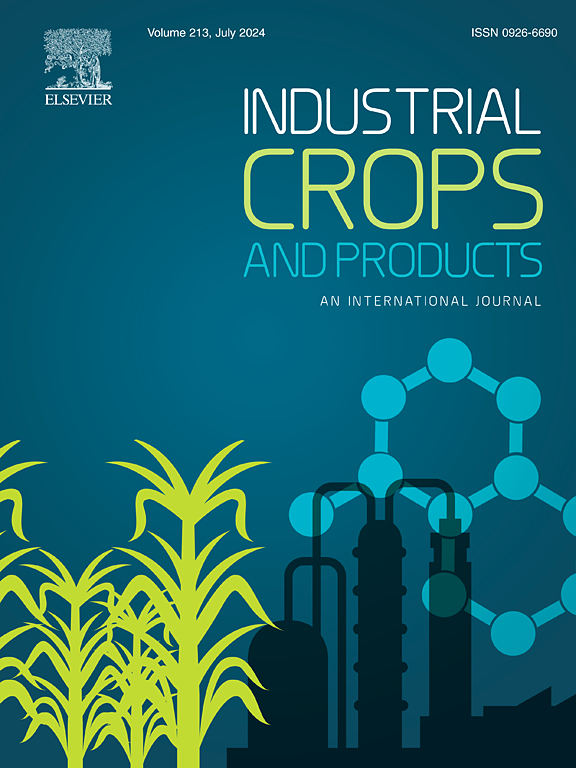综合多组学研究发现,Li-miR828z-LiMYB114调控模块在紫薇(Lagerstroemia indica)花色发育过程中控制花青素的生物合成
IF 5.6
1区 农林科学
Q1 AGRICULTURAL ENGINEERING
引用次数: 0
摘要
紫薇(Lagerstroemia indica)花色的形成受花青素生物合成的时空调控驱动,但其分子机制尚不清楚。本研究采用代谢组学、转录组学和小RNA测序等多组学方法揭示了花瓣发育过程中花色变化的调控机制。结果表明,花青素含量在花瓣发育过程中显著增加,特别是在S3期,花青素含量增加了2.68倍,与花瓣由淡粉色向鲜红色过渡的时间一致。代谢组学分析显示,随着花瓣发育,花青素积累与总黄酮含量呈正相关,花青素与总黄酮的比值从S1期的0.30增加到S4期的0.55。这进一步支持了花青素在花卉着色中的主导作用。转录组分析鉴定出11131个表现出阶段特异性表达模式的差异表达基因,其中花青素生物合成途径在S3阶段显著富集。加权基因共表达网络分析(Weighted gene co-expression network analysis, WGCNA)鉴定出一个包含41个转录因子和4个与花青素积累高度相关的结构基因的调控模块。值得注意的是,我们使用小RNA测序发现并验证了一种新的Li-miR828z-LiMYB114调节模块。Li-miR828z通过结合LiMYB114的靶序列直接抑制LiMYB114的表达,而LiMYB114作为转录激活因子直接结合花青素关键生物合成基因(LiC4H、lif3’h和LiANS)的启动子。该模块具有精确的时间调控:发育早期低表达的Li-miR828z和高表达的LiMYB114促进了花青素的合成,而后期增加的Li-miR828z则防止了色素的过度积累。我们的研究结果为紫薇花色素沉着和基因靶点的工程设计提供了重要的见解。本文章由计算机程序翻译,如有差异,请以英文原文为准。

Integrated multi-omics reveals Li-miR828z-LiMYB114 regulatory module controlling anthocyanin biosynthesis during flower color development in Lagerstroemia indica
The formation of flower color in crape myrtle (Lagerstroemia indica) is driven by spatiotemporal regulation of anthocyanin biosynthesis, yet its molecular mechanisms remain unclear. This study employed multi-omics approaches including metabolomics, transcriptomics, and small RNA sequencing to reveal the regulatory mechanisms of flower color changes during petal development. Results showed anthocyanin content significantly increased during petal development, particularly at stage S3 where it increased 2.68-fold, coinciding with the transition from pale pink to bright red. Metabolomic analysis revealed a positive correlation between anthocyanin accumulation and total flavonoid content as petal development progressed, with the anthocyanin-to-total flavonoid ratio increasing from 0.30 at stage S1 to 0.55 at stage S4. This further supports the dominant role of anthocyanins in flower coloration. Transcriptome analysis identified 11,131 differentially expressed genes that exhibited stage-specific expression patterns, with significant enrichment in anthocyanin biosynthesis pathways at stage S3. Weighted gene co-expression network analysis (WGCNA) identified a regulatory module containing 41 transcription factors and 4 structural genes highly associated with anthocyanin accumulation. Notably, we discovered and validated a novel Li-miR828z-LiMYB114 regulatory module using small RNA sequencing. Li-miR828z directly inhibits LiMYB114 expression by binding to its target sequence, while LiMYB114 functions as a transcriptional activator directly binding to promoters of key anthocyanin biosynthesis genes (LiC4H, LiF3'H, and LiANS). This module exhibits precise temporal regulation: low Li-miR828z and high LiMYB114 expression in early development promote anthocyanin synthesis, while increased Li-miR828z later prevents excessive pigment accumulation. Our findings provide key insights into flower pigmentation and genetic targets for engineering diverse crape myrtle flower colors.
求助全文
通过发布文献求助,成功后即可免费获取论文全文。
去求助
来源期刊

Industrial Crops and Products
农林科学-农业工程
CiteScore
9.50
自引率
8.50%
发文量
1518
审稿时长
43 days
期刊介绍:
Industrial Crops and Products is an International Journal publishing academic and industrial research on industrial (defined as non-food/non-feed) crops and products. Papers concern both crop-oriented and bio-based materials from crops-oriented research, and should be of interest to an international audience, hypothesis driven, and where comparisons are made statistics performed.
 求助内容:
求助内容: 应助结果提醒方式:
应助结果提醒方式:


